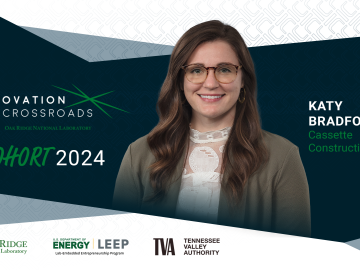
Filter News
Area of Research
- Biology and Environment (97)
- Biology and Soft Matter (1)
- Clean Energy (127)
- Climate and Environmental Systems (5)
- Computational Engineering (1)
- Computer Science (1)
- Electricity and Smart Grid (1)
- Functional Materials for Energy (1)
- Fusion and Fission (7)
- Isotopes (1)
- Materials (37)
- Materials for Computing (6)
- Mathematics (1)
- National Security (12)
- Neutron Science (13)
- Nuclear Science and Technology (1)
- Supercomputing (28)
- Transportation Systems (2)
News Topics
- (-) Environment (200)
- (-) Net Zero (14)
- (-) Partnerships (51)
- (-) Transportation (99)
- 3-D Printing/Advanced Manufacturing (128)
- Advanced Reactors (34)
- Artificial Intelligence (101)
- Big Data (60)
- Bioenergy (92)
- Biology (101)
- Biomedical (61)
- Biotechnology (24)
- Buildings (67)
- Chemical Sciences (73)
- Clean Water (31)
- Climate Change (105)
- Composites (30)
- Computer Science (198)
- Coronavirus (46)
- Critical Materials (29)
- Cybersecurity (35)
- Decarbonization (85)
- Education (5)
- Element Discovery (1)
- Emergency (2)
- Energy Storage (112)
- Exascale Computing (42)
- Fossil Energy (6)
- Frontier (45)
- Fusion (58)
- Grid (66)
- High-Performance Computing (93)
- Hydropower (11)
- Irradiation (3)
- Isotopes (57)
- ITER (7)
- Machine Learning (50)
- Materials (147)
- Materials Science (146)
- Mathematics (9)
- Mercury (12)
- Microelectronics (4)
- Microscopy (51)
- Molten Salt (9)
- Nanotechnology (60)
- National Security (72)
- Neutron Science (137)
- Nuclear Energy (111)
- Physics (64)
- Polymers (33)
- Quantum Computing (37)
- Quantum Science (72)
- Renewable Energy (2)
- Security (25)
- Simulation (51)
- Software (1)
- Space Exploration (25)
- Statistics (3)
- Summit (59)
- Sustainable Energy (130)
- Transformational Challenge Reactor (7)
Media Contacts

Three transportation researchers at the Department of Energy’s Oak Ridge National Laboratory have been elevated to senior member grade of the Institute of Electrical and Electronics Engineers, or IEEE.

Katy Bradford is on a mission to revolutionize the construction industry and is the founder of Cassette Construction, a company in the newest cohort of Innovation Crossroads, a DOE Lab-Embedded Entrepreneurship Program node at ORNL. As an Innovation Crossroads fellow, Bradford and her company will receive technical, financial and networking support to successfully advance the company’s products to the marketplace.

Scientists using high-resolution aerial scans and computational modeling concluded that wildfires, storms and selective logging have become key drivers behind rainforest carbon emissions, outpacing clear-cutting practices.

ORNL has partnered with Western Michigan University to advance intelligent road infrastructure through the development of new chip-enabled raised pavement markers. These innovative markers transmit lane-keeping information to passing vehicles, enhancing safety and enabling smarter driving in all weather conditions.

A team led by scientists at ORNL identified and demonstrated a method to process a plant-based material called nanocellulose that reduced energy needs by a whopping 21%, using simulations on the lab’s supercomputers and follow-on analysis.

As a mechanical engineer in building envelope materials research at ORNL, Bryan Maldonado sees opportunities to apply his scientific expertise virtually everywhere he goes, from coast to coast. As an expert in understanding how complex systems operate, he’s using machine learning methods to control the process and ultimately optimize performance.

A study found that beaches with manmade fortifications recover more slowly from hurricanes than natural beaches, losing more sand and vegetation. The researchers used satellite images and light detection and ranging data, or LIDAR, to measure elevation changes and vegetation coverage. Changes in elevation showed how much sand was depleted during the storm and how much sand returned throughout the following year.

In an impressive showcase of cutting-edge innovation and scientific prowess, ORNL has been recognized as a beacon of technological excellence, receiving 14 R&D 100 Awards, announced this week by R&D World magazine.

Seven entrepreneurs comprise the next cohort of Innovation Crossroads, a DOE Lab-Embedded Entrepreneurship Program node based at ORNL. The program provides energy-related startup founders from across the nation with access to ORNL’s unique scientific resources and capabilities, as well as connect them with experts, mentors and networks to accelerate their efforts to take their world-changing ideas to the marketplace.

A research team led by the Department of Energy’s Oak Ridge National Laboratory demonstrated an effective and reliable new way to identify and quantify polyethylene glycols in various samples.


